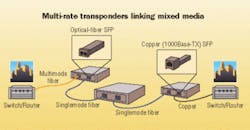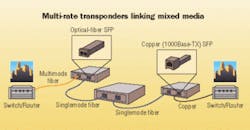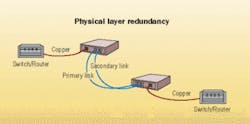In the world of perfect networks, every connection would begin and end on the same dedicated optical-fiber infrastructure. Older network elements, such as cabling and related equipment, would be discarded and replaced with the latest in optical transport technology.
But in the real world, it is simply too expensive and logistically prohibitive to make wholesale infrastructure and equipment upgrades. Media converters are the glue that holds these separate physical networks together, taking an incoming data signal from one type of media (such as 100-BaseTX (copper) and converting it for transmission onto another type of media (such as 100Base-FX (fiber). Since media converters function at the physical network layer, they do not interfere with higher layer functions, making the conversion process transparent to switches and routers as well as to the end user. In fact, converters can be used almost anywhere to connect different media types without affecting network functionality.
As new technologies have been introduced and adopted, however, the role of media converters has expanded well beyond simple connectivity. Applications for today's media converters include:
- Link extension (signal boosting);
- Signal repeating (multiple hop links);
- The creation of self-healing redundant links.
The benefits of media conversion can even be applied to Wave Division Multiplexing (WDM) applications where combined media and wavelength conversion can allow for greater deployment flexibility. (See "Media converter-based WDM," below.)
This trend is giving rise to the concept of the "infinite converter"—a physical layer converter that has the port, protocol and management flexibility that redefines the role that media converters play in the grooming and optimizing of optical-fiber networks.
SFP transceivers
Pluggable transceivers are among the most important advances in recent years for media converters, and in network installation and deployment in general. Pluggable transceivers are small, hot-swappable port interface modules that provide physical layer signaling for data, voice, storage and video transport networks. They are designed to provide significant advantages over traditional, fixed-form interfaces in terms of density, flexibility, management and cost savings.
Pluggables started with Gigabit Interface Converter (GBIC) modules, which provided Gigabit Ethernet network devices with a standard interface for optical transceivers. This enabled network administrators, for the first time, to select and change optical interfaces on a per-connection basis as needed. Today, GBIC has been upgraded to the small-form-factor pluggable (SFP) connectors.
Based on an industry-wide multiple source agreement, SFP transceivers are considerably smaller than GBIC transceivers, doubling possible port density. At the same time, SFPs are designed to support a much wider range of protocols and applications. Multimode, singlemode and even copper interface SFPs are available for everything from Fast Ethernet, Gigabit Ethernet, Fibre Channel and OC-48 to Gigabit Copper Ethernet, SDI/DVB and FireWire.
One particular type of SFP is capable of driving a gigabit-speed data link to 2 kilometers (km) or more over multimode fiber—far beyond the 550 meters per hop link distance set by the Gigabit Ethernet standard. The 2 km mark is significant because there remains a large amount of unused multimode fiber cabling left over from the days of fiber-distributed data interface (FDDI), which allowed for link distances of up to 2 km. These multimode-extending SFPs can now put that existing fiber to new use.
In addition to the wide selection of supported protocols, distances and media types, many optical SFPs and XFPs provide a powerful Digital Diagnostics tool for managing the optical interface. Digital Diagnostics is a multi-source agreement (SFF-8472) feature that monitors and reports on a number of interface parameters, including optical transmit and receive power, voltage and temperature measurement, wavelength, vendor code and serial number, and other items.
Where a fixed-interface media converter is limited to creating a single, specific type of connection, an SFP-enabled media converter can be a tool of virtually unlimited connectivity. Consider a common network with 10 SFP-based copper-to-fiber media converters where the optical-fiber interfaces are of three different kinds: multimode, 20-km singlemode, and 80-km singlemode. The spares needed for this network are limited to just one SFP-based media converter, one copper SFP, and one each of the two optical fiber SFPs. With fixed interface media converters, however, the spares inventory would have to contain three separate and complete media converters.
Multi-rate transponders
With SFPs providing flexibility on the interface side, the next area in need of improvement in the quest for the "infinite media converter" has become the electronics—the internal circuitry that forms the bridge from one side of the connection to the other. Traditionally, media converters have been engineered to handle one specific data rate; for example, if you needed a media converter that could handle copper-to-fiber conversion for Fast Ethernet, that's what you bought. But if later you needed to upgrade that connection with copper Gigabit Ethernet-to-fiber, you had to buy a whole new media converter and try to find another use for the old one.
Multi-rate transponders dramatically alter this equation by allowing for changes in data rate on-demand. Imagine a media converter that can support any speed protocol, from T-1 to 4-Gigabit Fibre Channel or higher. That is the promise of an SFP-enabled media converter engineered with multi-rate transponder capabilities—a single device that can do it all.
There are two types to consider. A 2R transponder reshapes and retransmits the incoming data signal in what is commonly referred to as signal conditioning. A 3R transponder, on the other hand, performs signal regeneration, meaning that it not only reshapes and retransmits the data signal but also retimes it.
For short-haul connections where signal jitter is not a concern, a 2R transponder media converter has the advantage of providing easy plug-and-play compatibility for any data rate within its range. You simply insert it in the SFP transceivers and plug in the cables. But for long-haul or multiple hop connections, and for connections where jitter sensitivity can be an issue (such as with video distribution), the 3R transponder media converter is the better choice since the desired data rate is "locked in" via device management. Some 3R transponder converters can be placed in 2R mode as well.
Applications for a multi-rate transponder vary by the type of SFPs employed. The unit can be used for anything from a straight media converter connecting network segments of different media types, to a wavelength converter connecting network elements operating at different wavelengths. For example, using the required SFPs, a multimode link operating at 850 nm can be connected to a singlemode link operating at 1550 nm. With incorporated 3R transponder functionality, two or more SFP-enabled media converters can even be deployed in sequence to create a communication link that spans hundreds of kilometers across a mix of media types (see figure, "Multi-rate transponders linking mixed media," page 26).
The SFP's compact design makes small and dual multi-rate transponder media converters possible, letting network administrators double capacity while reducing the number of converters needed. Some dual transponder converters can also function as a mini cross-connect, providing advance any-port-to-any-port connectivity, including physical layer multicasting. They can even be used to create self-healing redundant links for mission-critical applications.
Advanced management
In any network, the best way to avoid downtime is to catch a potential problem before it becomes a real problem, and the only way to catch a potential problem is by monitoring each element of the network. Managed media converters provide real-time information on operating and link parameters, and a logical interface for device configuration.
Today's managed media converters offer a number of advanced features that help maintain network performance and integrity. Redundant data paths are the best and most cost-effective way to ensure high availability in mission-critical networks. To achieve this goal, Layer 2/3 link state protocols, such as Spanning Tree, RIP and OSPF—designed to reroute data traffic around outages when they occur—are often employed. But the reconvergence times for these higher layer protocols can result in a noticeable drop in service and a loss of data.
For point-to-point connections, an alternative to higher-layer convergence protocols is physical layer link redundancy. A media converter designed for physical layer redundancy provides dual data and/or trunk ports, enabling the creation of alternate physical paths—one primary and the other secondary. Should the signal be lost on the primary link, the media converter instantly switches to the secondary path. (See figure, "Physical layer redundancy," page 27.) Because this process happens entirely at the physical layer and does not involve higher layer software functions, the switchover time occurs in less than 100 ns—so fast that the event remains transparent to both the network and the end user.
Link state propagation
For complex networks that rely on Layer 2/3 link state protocols, it is essential that every switch and router be aware of any change in network topology. Here is where traditional media converters can present an obstacle. If a media converter is used to connect a copper port on a router to a fiber trunk, what happens if the link on the fiber side of the media converter goes down? As far as the router is concerned, it still has an active link to the copper side of the media converter and is not aware that communication to the fiber side has been lost. The router's link state protocol is never triggered to reroute traffic around the problem.
The solution is a media converter that features the ability to propagate a change of link state from one side of the device to the other. Given different names by different vendors, the function of the link propagation feature remains the same. Taking the example from above, when the connection is lost on the fiber side, the media converter will respond by shutting down its copper port on the other side. Doing so will result in a loss of link on the router's port. The router can then activate the link state protocol to find a path around the problem.
The IEEE 802.3ah Ethernet in the First Mile draft outlines a method by which device management packets can be transmitted in-band along the same physical path as the user data while keeping the two logically separated. What this means for an 802.3ah-enabled media converter is that its ports can be remotely managed exactly as if they were local ports, but without the need of a remote management agent, remote IP address, or the use of SNMP.
There are several benefits to eliminating these elements. First, media converters that implement 802.3ah reduce capital expense in terms of equipment and set-up costs. In addition, they are able to provide additional management capabilities, such as remote loopback and remote software downloads—both of which improve operating expenses by reducing the need for service truck rolls, enhancing customer support, and ensuring maximum network up time. They also save on the use of IP addresses, of which there is not always a large supply.
The days of a media converter being "just a media converter" are over. It has become an essential tool for any network administrator, designer or installer. Indeed, today's media converter has become the "infinite converter."
Todd Rope is vice president of technology for MRV Communications (Chatsworth, CA; www.mrv.com)
Media converter-based WDM
The direct benefit of a wavelength division multiplexer (WDM) system is its ability to maximize the utilization of the existing fiber plant at a fraction of the time and expense of installing additional fiber. For many people, however, the mere mention of WDM still brings to mind images of highly complex and sensitive systems with six-figure, entry-level price tags. That is not the case with the new generation of SFP and multi-rate transponder media converters, which can be used to create an affordable, easily deployed and maintained, and highly flexible WDM solution.
The media converter-based WDM concept is straightforward. Configured with an edge device-specific SFP on one side and a wavelength specific optical SFP (CWDM or DWDM, depending on the application) on the other, each media converter performs a combination of both media and wavelength conversion. The wavelength-specific side of each unit is connected to an external and fully passive WDM mux/demux. Through the mux/demux, a bi-directional WDM trunk is created that extends and connects to another mux/demux where the media and wavelength conversion process is reversed for the edge devices at that end.
With the combined power of SFPs and multi-rate transponders, this WDM system lets network administrators mix-and-match the protocols and interfaces they need, and lets them deploy and change their network one data channel at a time. A WDM data channel can be altered in minutes with a simple swap of an SFP and, if necessary, a change in selected data rate.
The same media converters can also be used to create optical add/drop multiplexing (OADM) topologies, where a wavelength-specific data channel can be added/dropped at any point along the WDM trunk. They can even be used as WDM repeaters to extend the WDM trunk to great distances over multiple hops.—TR


